Carnival mass in Mainz, Germany
Carnival in Mainz, known locally as 'Fastnacht' or 'Fasching' has been celebrated for hundreds of years, becoming more formally organized in the 1800s.
Most of the carnival traditions of the city have remained the same since then, but a more recent tradition is very typical of the city and its attitude to life.
Early on the Sunday of Mainz carnival celebrations, people go in carnival costume to the magnificent Mainz Cathedral, the Mainzer Dom.
This is for the Carnival mass before the big parade of Rosenmontag or Rose Monday, the following day.
When the service is over and everyone spills out into the market place where the children’s fun fair has been set up, it is a delight of colour and of friends greeting friends.
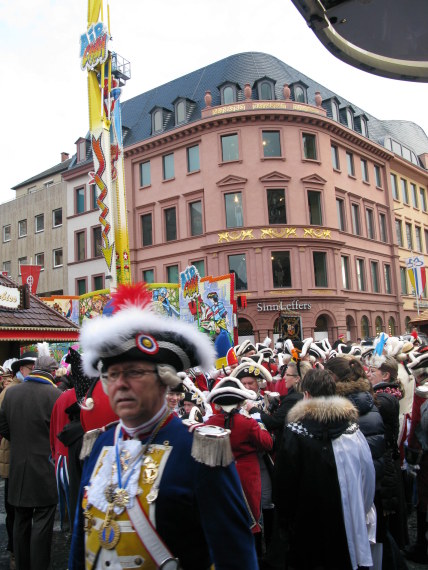
The various Carnival Garde troops are there in full regalia.
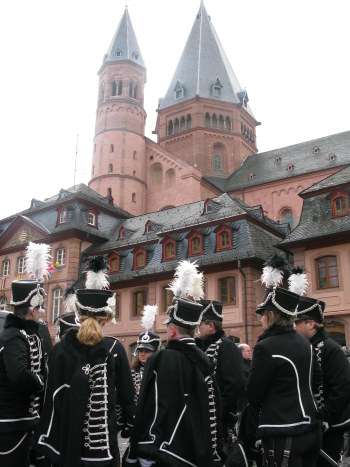
The market place outside the cathedral is a sea of feathery hats and colour.
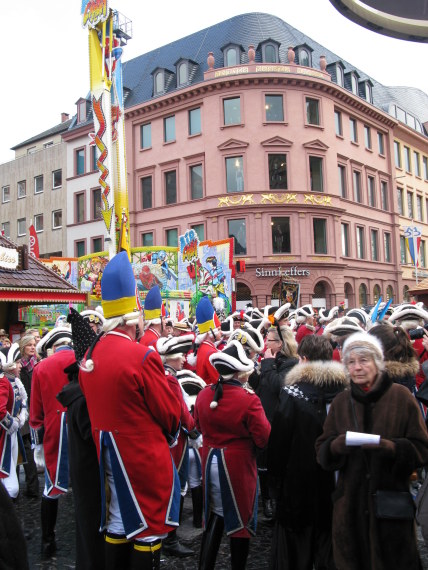
A cathedral full of costumes
The cathedral is packed with an estimated 2000 costumed people.
Those who are not early enough must stand throughout the Carnival mass service. These Garde members were not taking any chances and like me were early getting there in order to not just get a seat, but a good one.
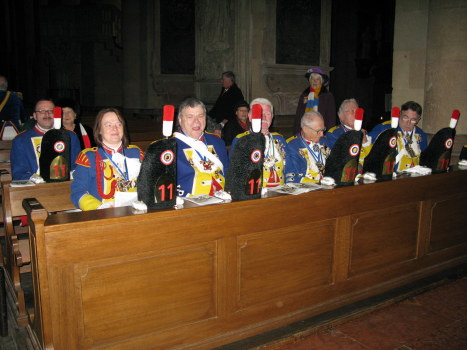
Set against the ancient bas relief sculptures under the mighty Dom of Mainz, the uniforms seemed somehow to be totally in character.
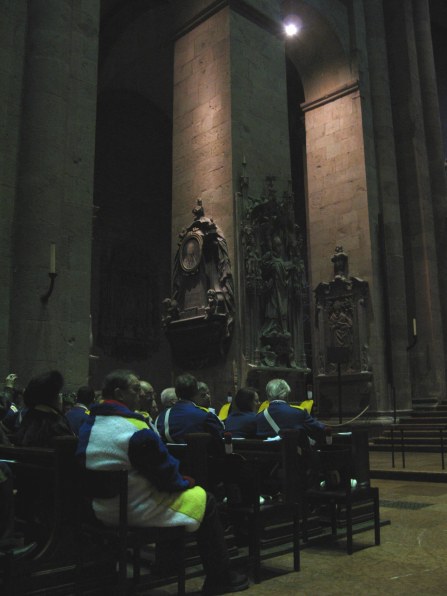
The Garde members had rested their rifles against the church column.
The local tradition of flowers in the barrels predate by some hundreds of years the same action by students during the American civil rights demonstrations of the 1960s.
It is indeed symbolic of a city that would definitely rather
Make love, not War.
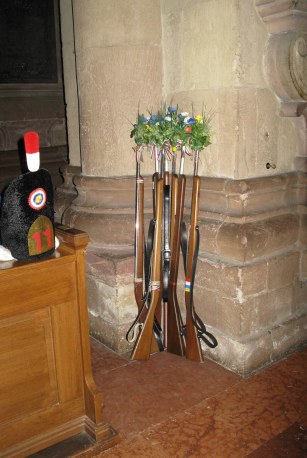
The Garde Standard Bearers escort the Bishop and the Holy Bible both to, and from, the Carnival mass.
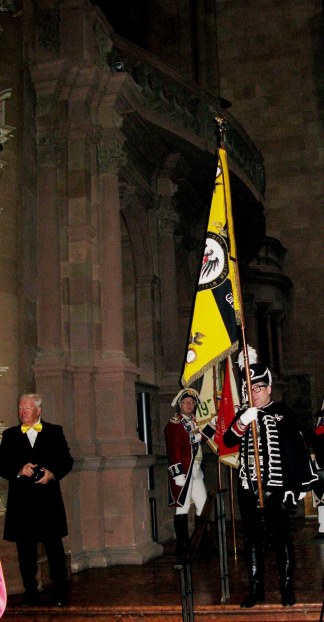
…and flank the steps during the ceremony.
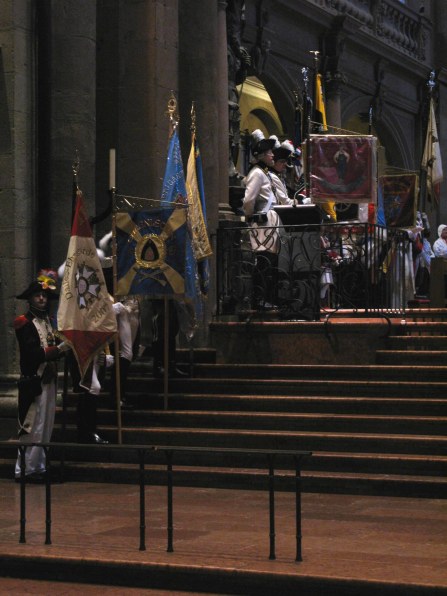
The massed standards and the Garde band and choir fill the West choir area around the high altar.
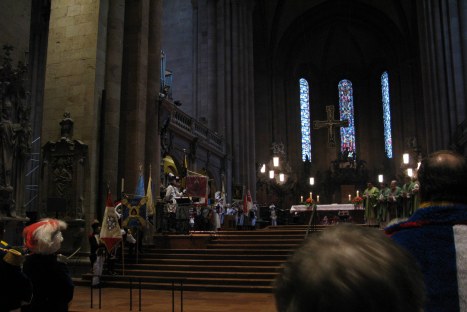
To see the feather-hatted uniforms before the altar seemed in keeping with the magnificence of the cathedral itself, as the Garde members assisted the mass celebration.
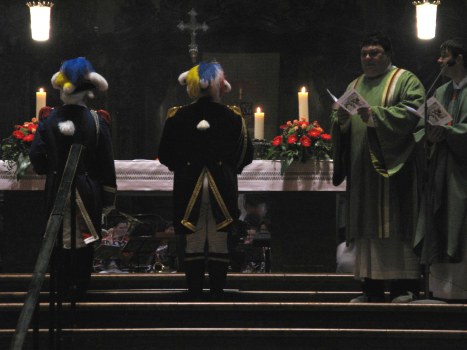
In a manner typical of Bishop Lehman, much loved Bishop of Mainz, in his closing statement before the final Carnival mass blessing at the end, they were thanked for doing so – along with all others who had contributed.
In 2012 a new standard was consecrated at the end of the mass.
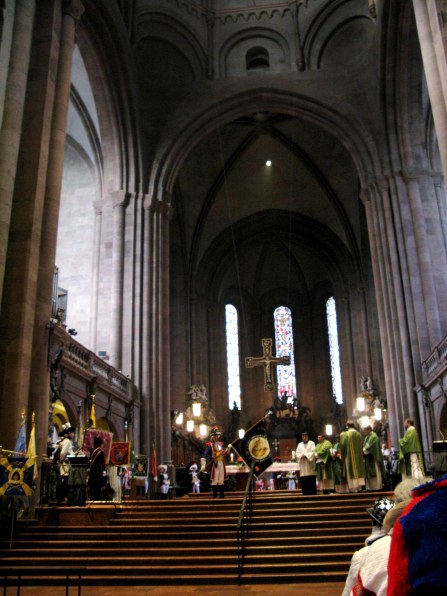
Mainzer Dom - the Mainz Cathedral since the year 911
The Mainz cathedral is a marvellous setting.
It was first consecrated in 911.
Under the leadership of Bishop Willig, the construction of what we now enjoy began.
Bishop Willig was an astute politician who became the Regent of the then Empire. He planned for the flourishing city of Mainz to be the second Rome. The design of the Dom reflects those aspirations, being close to that of St. Peter’s Basilica in Rome.
The cathedral has been the site of the crowning of six monarchs, and the Archbishop of Mainz is still the Pope’s representative north of the Alps.
After losing its prominence held during the Holy Roman Empire, the Holy See of Mainz was relocated, and it was not until 1802 that the modern Roman Catholic Diocese was established under the French.
To this day, Mainz retains papal permission for the cathedral chapter to elect its own bishop. It is unique throughout the world for this honour.
It was the current bishop, Karl Lehman, popular throughout the region with catholic and non-catholic alike, who responded positively to the suggestion to hold the Fastnacht Mass with people coming in costume.
Bishop Karl Lehman is not your ordinary bishop.
Mainz Cathedral - destroyed by the siege of the Prussians and rebuilt under Napoléon
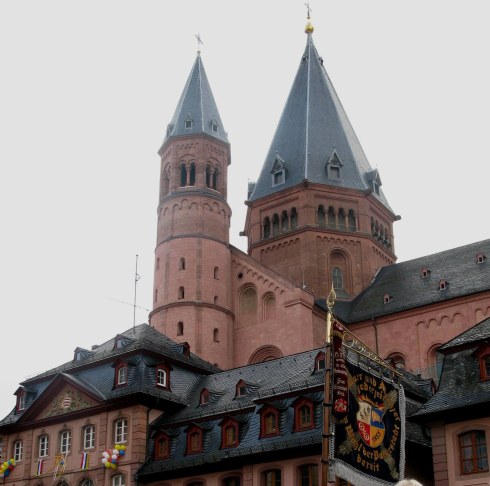
The octagonal dome was the inspiration of Henry IV. This was the ruthless and canny German monarch who was excommunicated five times by three different popes, but still managed to survive in power, despite causing civil war over his throne in both Italy and Germany .
The new construction followed fire that had for the second time struck the cathedral, this time damaging the dome and giving opportunity for a new design with similar features to that of the magnificent Speyer Cathedral which Henry had directed some years before.
The siege by the Prussians in 1792 ended the great Republic of Mainz and as the cathedral was badly damaged it was used as an armed camp, its wooden interior fixings being burned for heat.
It was the Bishop of Colmar under the support of Napoleon who started the restoration once more.
During World War II the Mainzer Dom was a popular target, sustaining direct hits several times. It was not fully restored until the late 1970s.
Having thanked God during the Carnival Mass in the cathedral, the Gardes move outside in a happy jumble of colour.
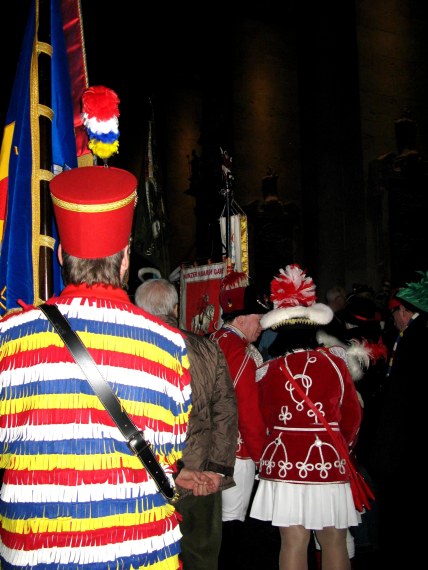
..and a jangling of swords.
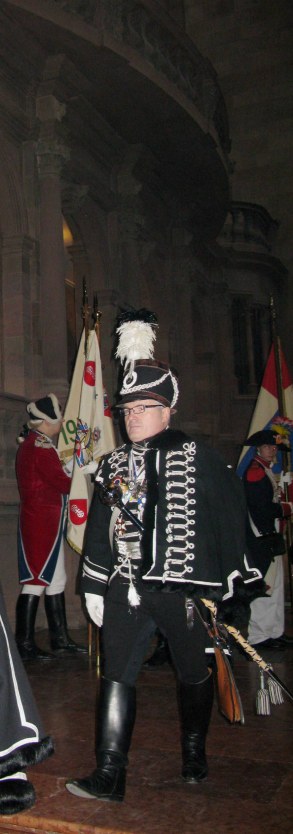
The drums were gathered up as the cathedral slowly emptied of its colourful mass celebrants.
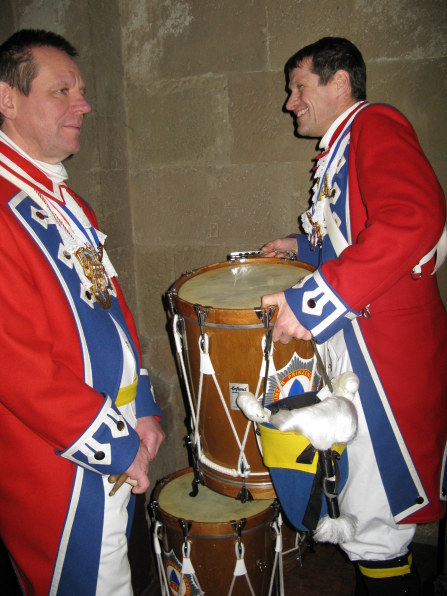
Behind the Standard of the Husaren or Hussar Garde…
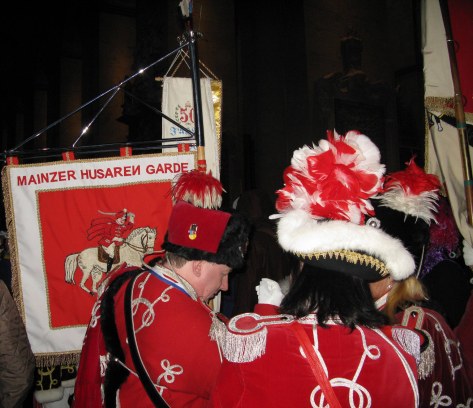
…the mingling of guards and costumes under the ancient lofty stonework and arches formed a kaleidoscope of colourful, smiling people.
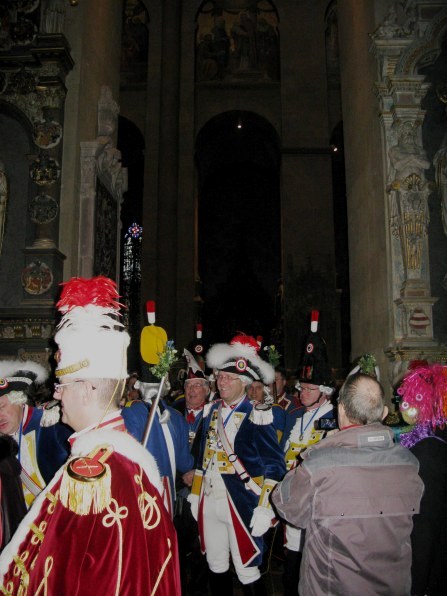
The statue of a former bishop looked on.
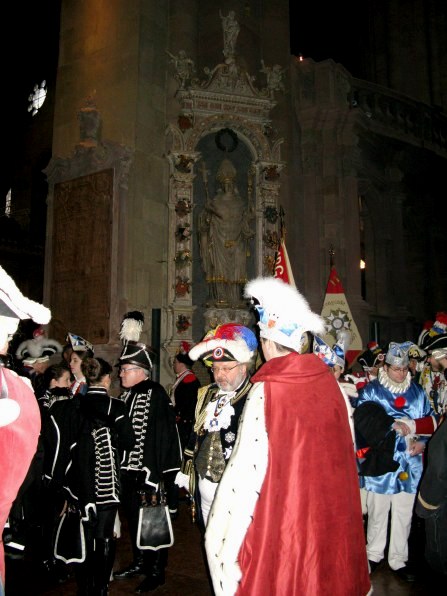
One wonders if such a celebration would have been possible in his time.
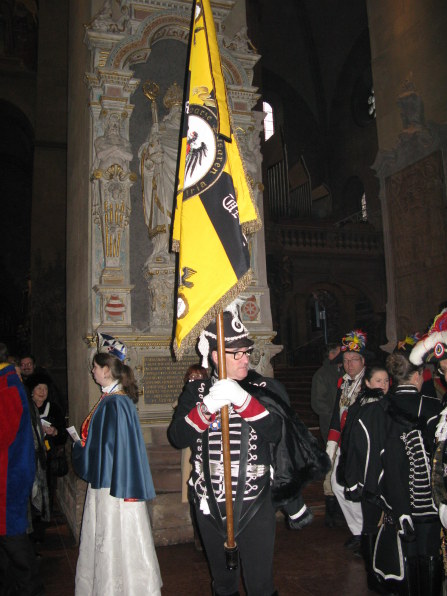
The laneway to the door of the Dom is narrow.
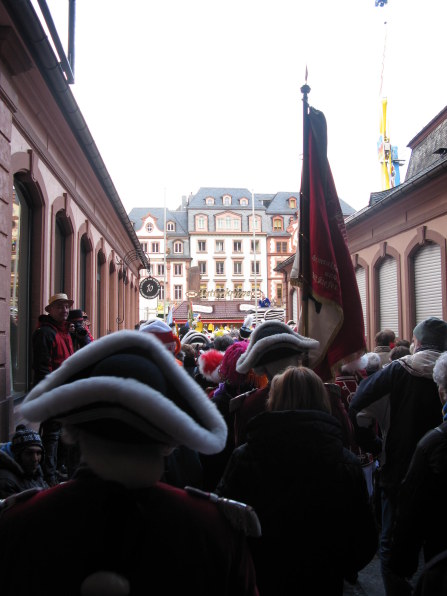
Beneath the feathery bonnets it is hard to locate your friends unless you know what costume they have this year, and can find it in the sea of costumes.
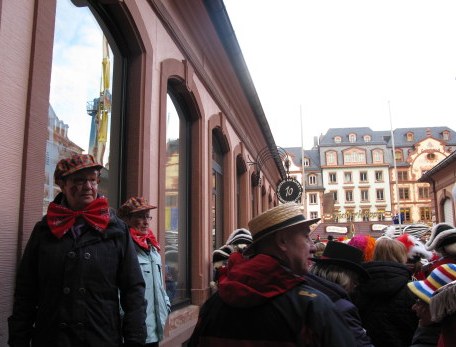
The crowd drifts into the market square.
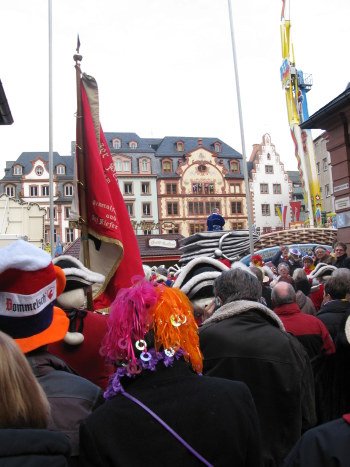
People seek out their friends and fellow guardsmen.
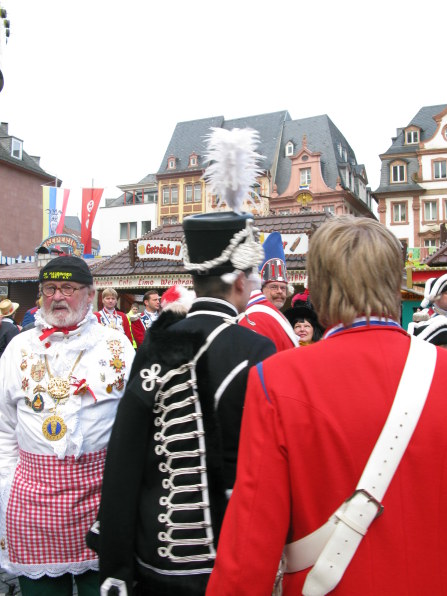
The market place becomes an undulating wave of colour and feathery hats.
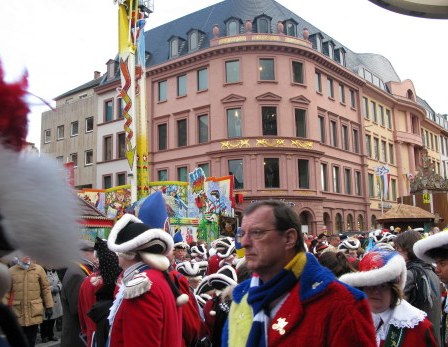
It is a chance to check out the men in uniform.
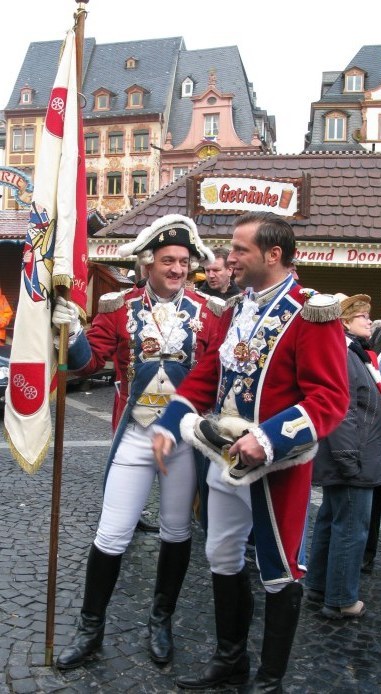
After the service, the Garde members gather together before the Dom before following their band to whatever locale is their Garde’s 5th Season watering hole.
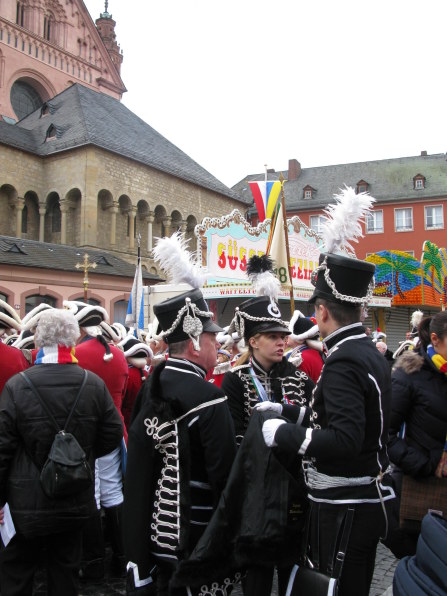
Some families seek the high ground in the children’s fun fair, so that they can be easily found amongst the mass of costumes.
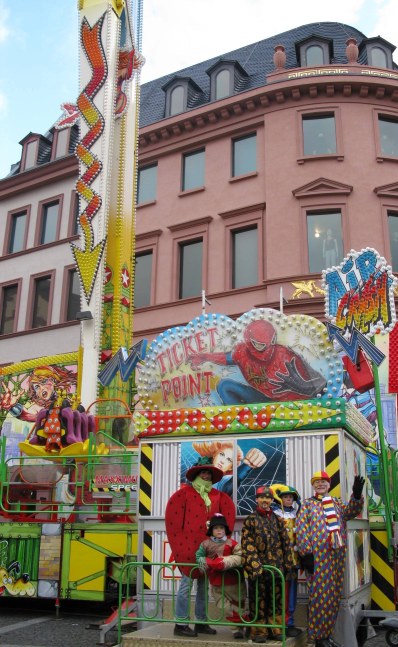
Bajass, the Fastnacht jester, eternally carrying his lamp, has a chance to catch up with old friends.
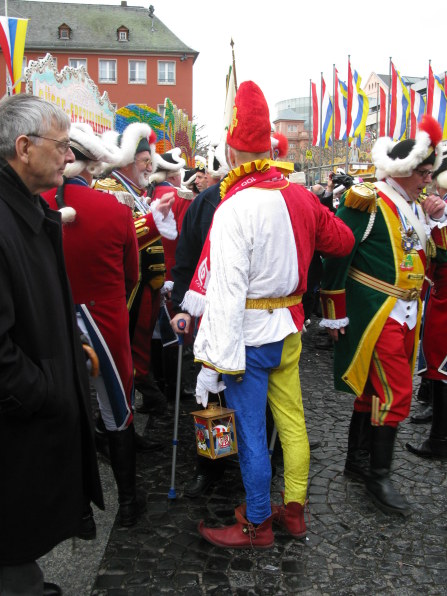
During the Carnival mass every time the jester moved there was a jangle of bells folowed by quiet smiles on the faces of the congregation.
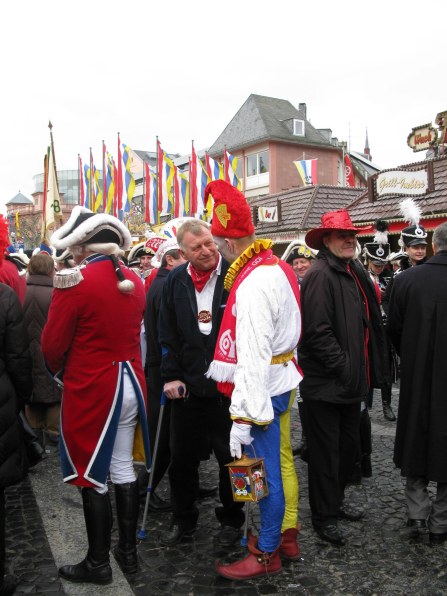
Despite the cold, people linger in the market place to meet and chat, with the Dom making a great backdrop to the pageantry.
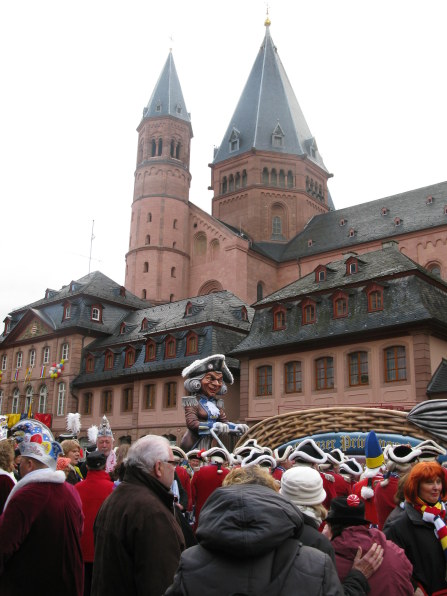
Eventually the crowd breaks up before the next parade starts.
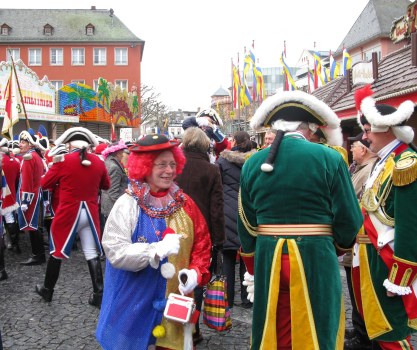
In the shadow of the Cathedral: Im Schatten des Doms
The Dom is a much loved symbol of Mainz and is the theme of the signature song of the football team Mainz 05 Im Schatten des Doms – in the Shadow of the Cathedral – here sung at the annual 'Mainz stays Mainz: Mainz Sings and Laughs' sitzung.
If you want to see how much this is the heartfelt anthem of the city...look at this crowd on Rosenmontag.
Im Schatten des Doms sung by the crowd in Schillerplatz
This Mainzer hymn says that all we who live in the shadow of the Dom will hold our flag high to swing in the wind – and together with the Fastnacht god, we sing a Halleluia to thank God that we are guests of this earth.
If you live in and fall in love with this city, it thrills you as you join the singing of this and other typically Mainzer songs.
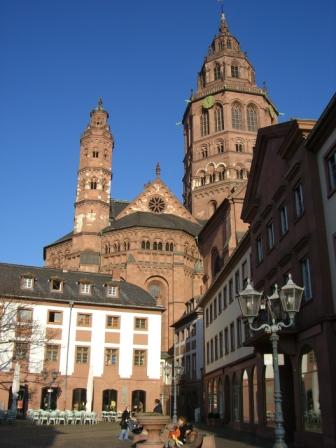
In the words of Billy Sunday, the American baseball star turned evangelist:
Going to church
doesn't make you a Christian
any more than standing in a garage
makes you a car
But for all the people attending mass in the Mainzer Dom in their carnival costumes and uniforms on Fastnacht Sunday, perhaps it is a part of celebrating both faith in God, and of being in a city that dares to be itself.
As the song says, we who love Mainz are thankful to be guests of this earth and to be living in the shadow of the Mainzer Dom.
I feel so fortunate to have done so.
Although it may be geographically distant, like New Orleans, Mainz stays always close to my heart as 'home'.
Other Mainz pages






